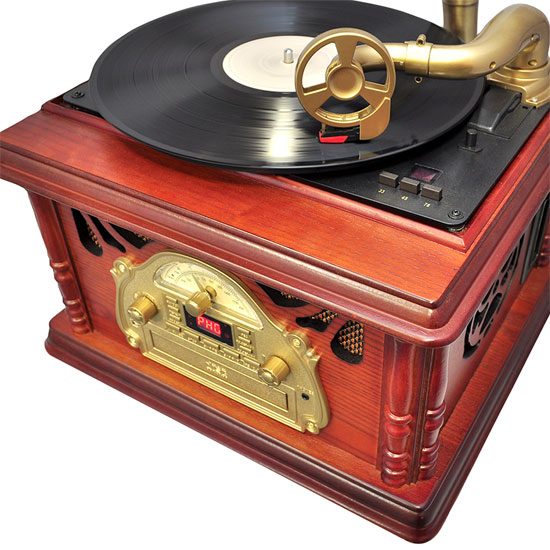

There is quite a good correlation between record size and play speed. So you’ll mainly find records made for 33 RPM or 45 RPM. Now, 78 RPM is very rare these days, but we’ll quickly cover why that is in the History of Vinyl Record Speeds section of this article. The three commonly recognized speeds are 33 1/3 RPM, 45 RPM, and finally 78 RPM. The pressings of a vinyl record are designed around this rotational speed.
#33 1 3 turntable full#
What this essentially means is how many times the platter on a turntable rotates a full circle each minute. RPM is an abbreviation for Revolutions Per Minute. If you’re short on time, you can only read the conclusion and you’ll walk away the most important bits of this article. So finally I’ll conclude all the previous sections in the conclusion to give a clear final answer. Then I’ll show some statistics of data I’ve gathered and share an expert’s opionion on the subject to provide some more context and validation for the conlcusion that comes afterwards. I’ll take record sizes and usability in consideration in this part too. Here I’ll look at the benefits and downsides of both. In the next part I’ll actually compare 33 RPM and 45 RPM records. The core of this article comes after this. Again, if you’re not interested in this you can just skip it. This is really just to give some extra context to me and you. I’ve added this just in case someone needed to quickly be brought up-to-speed.Īfter that I’ll quickly go over the history of vinyl record speeds. If you’re already familiar with this you can just skip that section. I’ll start with a brief explanation of what RPM is. Now that I’ve gotten that out of the way, I’ll quickly cover the topics I discuss in this article. Something I’d like to add, before I get into it, is when I refer to 33 RPM I’m actually referring to 33 1/3 RPM. So I decided to write an article about it. During my research on this, I found some significant differences that I found to be very interesting. On recent songs pressed with modern techniques, a 45 RPM record will definitely sound better than a 33 RPM.I’ve known the basic difference between turntable rotational speeds for a while now, but lately I’ve been wondering whether or not the assumptions I made were actually true or not. In short, a 45 RPM record sounds better than a 33 RPM 80% of the time, but not 100%. For this reason, it is not uncommon to hear a 45 RPM reissued after the original 33 RPM sounds worse. Indeed, even if the physics says otherwise, there are other factors to consider: the mastering, access to the original tape, quality of the pressing factory, etc. However, a 45 RPM may not always sound better than a 33 RPM. That’s the reason why 12″ 45 RPM is not the most common but is still used, especially for promoting songs.Ī 45 RPM record sounds better than a 33 RPM 80% of the time. Eventually, that’s multiplying the mastering cost, plating cost, pressing cost, labels, and jackets.

An LP or an album would need more disks to store everything. Therefore, if the songs are too long, you can only put one title, maybe 2, per face. Because of that, you engrave less music on a 12″ 45 RPM than a 12″ 33 RPM record. Indeed, 45 RPM is faster than 33 RPM by 36%. Then, why aren’t all records 12″ 45 RPM? The reason goes down to cost. It can therefore store more audio information per second and sounds better. Indeed, the outer edge of the 12″ is bigger than the outer edge of the 7″. Therefore, a 45 RPM record will also have a better sound quality in the central grooves.įor the same reason, a 12″ 45 RPM record sound quality is better than a 7″ 45 RPM. Increasing the rotational speed – the RPM – will increase the distance traveled per second, thus increasing the audio quality. In the table above, I only focused on the most common sizes when someone mentions 33, 45, and 78 RPM records. As the 33 and 45 RPMs are the most common speeds on turntables, some music labels like to make odd sizes from time to time for special occasions. Indeed, you may find records as small as 3″ in Japan or old 16″ from the 30s. The same as any size records can be made 33 or 45. In fact, 10″ can also be made in 33 or 45 RPM real vinyl. They came from an ancient time when styli needed to be changed very often and were not made from diamonds. They are usually thicker and not flexible as vinyl. The 10″ 78 RPM records are not really vinyl since they are made of shellac. I focus more on the difference in sound quality later in this post. They can be used for promotion on the radio for instance. They are mostly used for singles and for their higher sound quality. They are easy to differentiate thanks to their size.Īfter that, the most common records are the 12″ 45 RPM vinyl.


 0 kommentar(er)
0 kommentar(er)
